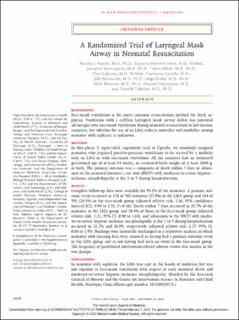| dc.contributor.author | Pejovic, Nicolas | |
| dc.contributor.author | Höök, Susanna Myrnerts | |
| dc.contributor.author | Byamugisha, Josaphat | |
| dc.contributor.author | Alfvén, Tobias | |
| dc.contributor.author | Lubulwa, Clare | |
| dc.contributor.author | Cavallin, Francesco | |
| dc.contributor.author | Nankunda, Jolly | |
| dc.contributor.author | Ersdal, Hege Langli | |
| dc.contributor.author | Blennow, Mats | |
| dc.contributor.author | Trevisanuto, Daniele | |
| dc.contributor.author | Tylleskär, Thorkild | |
| dc.date.accessioned | 2021-04-30T08:28:10Z | |
| dc.date.available | 2021-04-30T08:28:10Z | |
| dc.date.created | 2020-12-14T19:26:04Z | |
| dc.date.issued | 2020 | |
| dc.Published | New England Journal of Medicine. 2020, 383 (22), 2138-2147. | |
| dc.identifier.issn | 0028-4793 | |
| dc.identifier.uri | https://hdl.handle.net/11250/2740498 | |
| dc.description.abstract | Background: Face-mask ventilation is the most common resuscitation method for birth asphyxia. Ventilation with a cuffless laryngeal mask airway (LMA) has potential advantages over face-mask ventilation during neonatal resuscitation in low-income countries, but whether the use of an LMA reduces mortality and morbidity among neonates with asphyxia is unknown.
Methods: In this phase 3, open-label, superiority trial in Uganda, we randomly assigned neonates who required positive-pressure ventilation to be treated by a midwife with an LMA or with face-mask ventilation. All the neonates had an estimated gestational age of at least 34 weeks, an estimated birth weight of at least 2000 g, or both. The primary outcome was a composite of death within 7 days or admission to the neonatal intensive care unit (NICU) with moderate-to-severe hypoxic–ischemic encephalopathy at day 1 to 5 during hospitalization.
Results: Complete follow-up data were available for 99.2% of the neonates. A primary outcome event occurred in 154 of 563 neonates (27.4%) in the LMA group and 144 of 591 (24.4%) in the face-mask group (adjusted relative risk, 1.16; 95% confidence interval [CI], 0.90 to 1.51; P=0.26). Death within 7 days occurred in 21.7% of the neonates in the LMA group and 18.4% of those in the face-mask group (adjusted relative risk, 1.21; 95% CI, 0.90 to 1.63), and admission to the NICU with moderate-to-severe hypoxic–ischemic encephalopathy at day 1 to 5 during hospitalization occurred in 11.2% and 10.1%, respectively (adjusted relative risk, 1.27; 95% CI, 0.84 to 1.93). Findings were materially unchanged in a sensitivity analysis in which neonates with missing data were counted as having had a primary outcome event in the LMA group and as not having had such an event in the face-mask group. The frequency of predefined intervention-related adverse events was similar in the two groups.
Conclusions: In neonates with asphyxia, the LMA was safe in the hands of midwives but was not superior to face-mask ventilation with respect to early neonatal death and moderate-to-severe hypoxic–ischemic encephalopathy. | en_US |
| dc.language.iso | eng | en_US |
| dc.publisher | Massachusetts Medical Society | en_US |
| dc.title | A randomized trial of laryngeal mask airway in neonatal resuscitation | en_US |
| dc.type | Journal article | en_US |
| dc.type | Peer reviewed | en_US |
| dc.description.version | publishedVersion | en_US |
| dc.rights.holder | Copyright © 2020 Massachusetts Medical Society. All rights reserved. | en_US |
| cristin.ispublished | true | |
| cristin.fulltext | original | |
| cristin.qualitycode | 2 | |
| dc.identifier.doi | 10.1056/NEJMoa2005333 | |
| dc.identifier.cristin | 1859723 | |
| dc.source.journal | New England Journal of Medicine | en_US |
| dc.source.40 | 383 | |
| dc.source.14 | 22 | |
| dc.source.pagenumber | 2138-2147 | en_US |
| dc.relation.project | Norges forskningsråd: 250531 | en_US |
| dc.identifier.citation | New England Journal of Medicine. 2020, 383, 2138-2147. | en_US |
| dc.source.volume | 383 | en_US |
